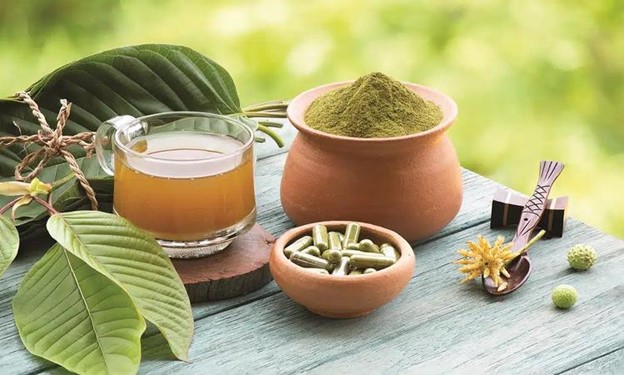
Kratom Extract Vs Powder: What You Need to Know
In the world of natural supplements, kratom is distinguished by its unique effects and consumption methods. For both seasoned users and newcomers, understanding the differences between kratom extracts and powder is crucial.
Our article, “Kratom Extract vs Powder: What You Need to Know,” thoroughly explores each form. We’ll start with definitions of kratom powder and extract, delve into their differences, and discuss production methods. The best consumption methods, including the toss-and-wash technique, tea, and capsules, will be covered.
Additionally, we will explain why extracts are typically stronger, how to measure doses, and suggest appropriate amounts for consumption accurately. This article provides essential insights to help you make informed decisions about using kratom extracts vs powder. If you’re starting to use kratom for your well-being, consider happy go leafy kratom extracts for top-quality kratom products.
What Is Kratom Powder?
Kratom powder or crushed kratom leaf is the most commonly observed form of kratom, a tropical tree species of African country originating from Southeast Asia (Thailand, Malaysia, Indonesia, etc.).
The leaves of the kratom tree bear alkaloids, a class of compounds that include mitragynine and 7-hydroxymitragynine. These alkaloids are the most noticeable ones. This is an alkaloid, which is attractive for vomiting and sedation.
Through this process of sourcing kratom leaves, they need to be dried out before they can be turned into kratom powder. Processing can be different, but it’s normally done in a controlled environment, either indoors or outdoors under sunshine.
Kratom leaves, when they dry, are ground, which is what the Kratom comes in, which is how it is sold as well as used. Due to the pellet having a direct physical connection with leaf type and the drying process, the color of the powder varies from light to dark green.
Kratom powder is valued for its versatility. It can be consumed directly, added to food or drinks, or encapsulated. It allows users to adjust dosages precisely, contributing significantly to its popularity.
Its effects can range from stimulating to sedative depending on the strain, dosage, and individual user, making it a flexible option for those looking to manage everything from pain to fatigue to mood.
What Is Kratom Extract?
Kratom extract is a highly concentrated form of kratom, made from the boiling down of kratom leaves or powder concentrates to remove the alkaloids that constitute its effect. The objective is to produce something more powerful than regular kratom, where a much smaller amount is highly effective in achieving what the usual dosage can do.
The process is a series of stages, one of which is soaking kratom in water or a water-alcohol mixture to break the active alkaloids down. To further purify the liquid, it is then sieved to filter the residual plant matter. Next, it is cooked to produce a more concentrated paste or dried and formed into a crystalline extract.
This result is stronger per gram than kratom powder due to taking into account high alkaloids for example, mitragynine and 7-hydroxymitragynine alkaloids. Kratom extracts are typically labeled with a ratio (such as 10). There is almost no variety: Herbal Remedies range from 1 to 15:1, suggesting higher potency of their kratom.
They are mostly taken by people who want more long-term effects and those who need bigger doses of tetrahydrocannabinol due to tolerance problems. Extracts can be mixed with regular kratom powder, added to beverages, or consumed alone.
However, due to their potency, users must dose them carefully to avoid potential side effects.
What is The Difference Between Kratom Powder and Extract?
1. Concentration of Alkaloids:
Kratom powder is made by grinding dried leaves of the kratom tree. It contains the natural concentration of alkaloids present in raw leaves. In contrast, kratom extract is a much more concentrated form where these alkaloids are extracted through a boiling process. This results in a product with a much higher density of alkaloids than the powdered leaf.
2. Method of Preparation:
Making kratom powder is fairly simple: leaves are plucked, dried, and ground into a fine powder. This simplicity retains most of the leaf’s original chemical composition. In contrast, making kratom extract involves several more complex steps.
The leaves are boiled to extract the potent alkaloids and then further processed to remove excess water, resulting in either a thick paste or a dry, granular substance. This process concentrates the active ingredients significantly.
3. Potency:
Due to the concentrated alkaloids, kratom extract is significantly more potent than kratom powder. This means that users need fewer extracts to achieve the desired effects. Extracts are often labeled with a ratio to indicate their strength relative to powder (e.g., 10:1 indicates that 10 grams of leaves were used to produce 1 gram of extract).
4. Consumption:
Kratom powder is multifunctional; it can be used in tea and be mixed with food or consumed directly through the “toss it and wash it method. Yet, people find its bitterness very off-putting.
Not to mention that kratom extract is more potent, and therefore, lesser quantities of it might be used by patients than pure kratom leaf. It can be found in many ways, which include capsules and gel pills for those who can’t tolerate the raw flavor of kratom.
5. Cost and Accessibility:
Kratom powder is generally cheaper and more widely available than extract. The extensive processing required to make extracts makes them more expensive and sometimes harder to find.
6. Side Effects:
The higher potency of extracts increases the risk of side effects, including nausea, dizziness, and psychological effects like anxiety or dependency, especially at higher doses. Therefore, it requires careful dosage management, whereas kratom powder, being less potent, might offer a more forgiving margin in terms of dosage precision and side effects.
What Is the Method of Making Kratom Powder?
The difference between kratom powder and kratom extract is substantial, revolving around their alkaloid concentration, preparation methods, potency, consumption modes, cost, and potential side effects.
Concentration of Alkaloids:
Kratom powder is essentially dried and ground leaves containing the plant’s natural alkaloids, whereas kratom extract is a concentrated form resulting from boiling down the leaves to extract alkaloids, making it much denser in these compounds.
Method of Preparation:
Kratom powder is prepared by harvesting, drying, and grinding the leaves, which retains most of the leaf’s original properties. Extracts, however, involve boiling the leaves, straining the solution, and reducing it to a concentrated form, intensifying the active ingredients.
Potency:
Due to this concentration of alkaloids, extracts are more potent than powder. A much smaller quantity of extract is required to achieve effects that would need larger amounts of powder, often denoted by ratios like 10:1 on product labels indicating its increased strength.
Consumption:
Powder is versatile and can be used in teas, foods, or directly, although its taste can be off-putting to some. Extracts, being stronger, are used in smaller doses and come in various forms like tinctures and soft gels, which are more convenient for those averse to the powder’s flavor.
Cost and Accessibility:
Powder is generally less expensive and more readily available than extract, which is pricier due to its complex production process.
Side Effects:
The higher potency of extracts also raises the risk of side effects, such as nausea and psychological impacts like anxiety, necessitating careful dose management. Powder, being milder, offers a lower risk and a more forgiving usage experience in terms of side effects.
Overall, the choice between kratom powder and extract depends on the user’s needs for potency, cost, taste, and ease of use. Each form has its advantages and considerations, making it important to choose based on individual requirements and tolerance levels.
What Is the Method of Making Kratom Extract?
Kratom manufacture involves several intricate processes whose common goal is to concentrate alkaloid levels to create a stronger product compared to regular kratom powder.
1. Selection and Preparation of Leaves:
Choose the best kratom leaves and wash them carefully to remove all the impurities and keep the concentrate clean and clear.
2. Extraction Process:
Boil the leaves in water or a water-ethanol mixture to extract the alkaloids. This process varies in duration and temperature, depending on the desired strength of the extract.
3. Filtration:
After boiling, the mixture is filtered to separate the liquid, rich in alkaloids, from the solid leaf residues.
4. Concentration:
Evaporate the water from the liquid to concentrate the alkaloids further. This can be achieved through slow heating or advanced evaporation techniques, resulting in a thick paste or resin.
5. Drying:
If a dry extract is desired, the paste is dried until it hardens, then ground into a powder. This form is significantly more potent than kratom powder.
6. Testing and Standardization:
Lab testing may be conducted to measure alkaloid content, allowing for the standardization of potency and quality across batches.
7. Packaging:
Package the extract securely to prevent contamination and preserve potency and effectiveness during storage and transportation.
Which Is the Best Way to Consume Kratom Powder or Extract?
1. Toss and Wash Method:
This is one of the fastest and easiest ways of ingesting kratom powder. It starts with portioning the powder the size you want, then introducing it into your mouth and following it up with a large gulp of water. The toss-and-wash method is convenient and informal, but some may prefer something else to the raw powder flavor and feel.
2. Kratom Tea:
The making of tea is the favorite manner of taking powder and extract of kratom, which is a routine procedure. Eliminate powder or extract in the kratom tea preparation procedure for around twenty to thirty minutes in boiling water.
This method makes the bitter taste-neutral, which can then be improved by adding honey, lemon, and many other tastemakers. Kratom tea consumption is another way of benefitting from its effects, and the addition of certain flavors and the change in the drink’s strength is an easy process.
3. Capsules:
Both are similar because capsules are a convenient and safe way to consume kratom. They are highly preferred by people who cannot handle grown-up kratom taste or who need defined dosages. They can be packed with either kratom powder or extract, and this makes them adaptable as well as convenient.
4. Kratom Smoothies or Shakes:
Adding kratom powder or extract to a smoothie or shake will help patients enjoy kratom more, as this will allow them to swamp the bitter taste. Another thing the flavor and additional ingredients from your smoothie could do to hide the bitterness of kratom is to bring down the flavor and other ingredients. This method also allows for nutritional additions to your kratom routine.
5. Kratom Edibles:
Using kratom in edibles, such as baked goods or gummies, is an innovative consumption method. It avoids the herbal taste entirely, though it requires some culinary skill to ensure proper dosage and palatability.
Each method has its advantages and can be chosen based on personal preferences for convenience, taste, and how quickly the effects are felt. For instance, the toss and wash method and capsules offer quick preparation and consumption, while teas and edibles may have a more gradual onset of effects due to the digestion process. Ultimately, the best way to consume kratom depends on individual needs and lifestyle considerations.
Why is Kratom extract stronger?
Kratom extract is significantly stronger than kratom powder mainly due to its concentration process. During the extraction process, active alkaloids, for example, mitragynine and 7-hydroxymitragynine, are separated and concentrated using them.
This technique is based on brewing plant components, filtration, and boiling down the remainder. Therefore, the prepared dose contains a much higher dose of alkaloid than is usually found in natural leaf or in powdered forms.
For instance, a kratom extract labeled as 10:1 indicates that it is ten times more concentrated than the equivalent amount of powder. This higher concentration allows users to achieve desired effects with much smaller extract quantities than powder.
Therefore, extracts are especially appealing to those seeking stronger effects or those who have developed a tolerance to standard kratom powder.
However, the potent nature of kratom extract also increases the risk of side effects. Users must be cautious with dosages to avoid potential adverse reactions.
Due to its strength, kratom extract is often recommended for more experienced users who understand their tolerance levels and the substance’s effects, ensuring a safe and effective experience.
How to Measure Kratom?
Potency, which varies from one strain and form of kratom (e.g., powder vs. extract) to another, calls for accurate measurement of the substance for the users to employ it safely and effectively. Here are the most reliable methods and tools for measuring kratom:
Digital Scale:
The most precise way to weigh kratom is by having a digital scale whose resolution is at least as accurate as 0.1g. This is especially crucial for potent kratom extracts, which warn of their high doses; in these cases, you will most likely have to stick to a particular dosage to avoid potential problems.
Measuring Spoons:
A digital scale can be used if the scale is not available. However, measuring spoons are a good alternative for kratom powder. The membership inside a regular teaspoon is approximately 2 to 2.5 grams, and a spoon is around 7 to 8 grams. However, this method could be more precise due to variability in powder density.
Capsules:
Kratom capsules provide convenience and precision, typically coming in sizes like “00” which contains about 0.5 grams of kratom. They eliminate the need for manual measuring and allow for discreet consumption.
Volume Measurement:
For liquid kratom extracts, using a measuring dropper or syringe ensures accurate dosing.
Starting with lower doses is recommended when trying new strains or forms of kratom or if you are a new user. This allows you to safely adjust the dosage based on your body’s reaction and desired effects.
How Much Kratom Extract to Take?
Deciding on the right dosage of kratom extract, which is more concentrated than kratom powder, may require thoughtful deliberation, taking into account its higher concentration levels. Kratom extracts are labeled with the key parameter controlling their strength, ‘the ratio,’ which is relative to the original leaf. For instance, a 10:1 extract is ten times more potent than the leaf.
Given this potency, it’s essential to start with a smaller dose of kratom extract compared to powder. A common starting point is about 0.5 grams or less, depending on the extract’s strength. This approach helps minimize potential adverse side effects and allows you to gauge how your body reacts.
You can cautiously increase the amount if the initial dose doesn’t achieve the desired effects. However, adjustments should be gradual, with each dose thoroughly evaluated for effects before any increase.
For those new to kratom extract, consulting experienced users, or reliable informational resources can be beneficial. Everything your body shows you in response to each dose should be very strictly observed. If you find any adverse events, maintain or decrease the dosage or even stop the usage. Through the initial trial of a smaller dosage and increasing it gradually, you will find the optimal dosage that works for you, and the benefits become noticeable.
Conclusion
In conclusion, understanding the distinctions between kratom extract and powder is crucial for both new and experienced users. Our comprehensive guide, “Kratom Extract vs Powder: What You Need to Know,” explores each form’s production methods, differences, and consumption techniques.
While kratom powder is versatile and user-friendly, extracts offer greater potency, suitable for those needing stronger effects or managing tolerance. We also discuss responsible dosing and the importance of precise measurement.
This article aims to equip you with the necessary insights to make informed decisions about using kratom safely and effectively, helping you maximize benefits while minimizing risks.
FAQs
Can Kratom be addictive?
Kratom is addictive due to its psychoactive effects. Long-term and repeated use, especially in high doses, can cause addiction. People may show disadvantages like irritated mood, emotional variations, or some physical discomfort when try to get rid of or reduce the intake. It is of utmost significance to take kratom while being aware of its explicit side effects.
How to consume kratom powder?
Either fresh or as a powder, Kratom appeals to the taste of a very demanding consumer, opening up many avenues to choose one’s favorite variant. Highly used options include mixing it with water, juice, and smoothies, brewing it, and swallowing the powder down with liquid. This also varies each method may also affect the dosage, which in turn will affect the personal preference.
Can You Overdose On Kratom?
Unlike with other opiates, which are overdosed more often, it is possible to use kratom over-indulgence when kratom is taken in large amounts or along with other substances. The symptoms of overdose are varied but can be characterized by very severe drowsiness, hallucination, nausea, hypertension and the manifestation of respiratory distress in extreme cases.
How to Take Kratom Powder?
Kratom powder can be consumed using the grind and wash way, which means is the water comes into play, and the powder is ingested while being thrown back into one’s mouth with a cup of water. On the other hand, it can be made as tea, blended with food or/ drinks in absorption, and taken as capsules for a controlled dosage. Everyone has their own working style and preferences, and some of them may benefit more from a different approach.
Does Kratom Get You High?
Kratom can produce euphoria at higher doses as the alkaloids mitragynine and 7-hydroxymitragynine bind to the opiate receptors in the brain. Usually, it leads to analgesia, euphoria, and opioid withdrawal, which can be very helpful. The sensation can be quite different, depending on the quantity and strain of kratom being consumed.









Thank you for sharing this information